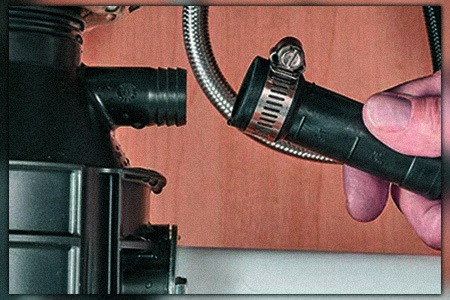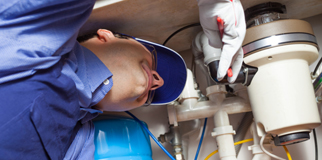Easy Ways to Repair a Leaky Waste Disposal Unit
Easy Ways to Repair a Leaky Waste Disposal Unit
Blog Article
Were you interested in resources The Handy Guide To Fixing Your Garbage Disposal Leaking?

Waste disposal unit are necessary kitchen appliances that help in taking care of food waste efficiently. However, a leaking garbage disposal can be an aggravating and untidy problem to take care of. Thankfully, numerous leaks can be dealt with conveniently with a couple of easy steps. In this write-up, we will certainly talk about just how to fix a dripping garbage disposal efficiently.
Intro
Waste disposal unit are set up under cooking area sinks and are created to shred food waste right into smaller sized items, allowing it to pass through the plumbing system easily. While these tools are typically reliable, leakages can happen in time as a result of wear and tear, loose connections, or damage to the system.
Usual Causes of Leakages in Rubbish Disposals
Worn Seals and Gaskets
Seals and gaskets play a critical duty in avoiding water from leaking out of the garbage disposal. Over time, these components can deteriorate, bring about leaks around the disposal unit.
Loose Links
The links between the waste disposal unit and the plumbing system can come to be loosened in time, creating water to leakage out during operation.
Cracks or Holes in the Disposal Unit
Physical damage to the waste disposal unit, such as fractures or openings in the housing, can additionally result in leakages.
Identifying the Resource of the Leakage
Prior to trying to deal with a dripping waste disposal unit, it is necessary to determine the resource of the leak. This can generally be done with aesthetic assessment or by conducting basic tests.
Visual Assessment
Examine the garbage disposal unit very carefully for any type of indicators of water leak. Pay attention to areas around seals, gaskets, and link points.
Checking for Leaks
One way to test for leaks is by running water with the disposal device and looking for any noticeable indicators of leakage.
Tools and Products Needed for Repairing a Leaking Waste Disposal Unit
Prior to starting the repair work procedure, gather the necessary tools and products, consisting of a screwdriver, adjustable wrench, plumbing professional's putty, replacement seals or gaskets, and epoxy or patching product for fixing cracks or holes.
Step-by-Step Overview to Repairing a Dripping Waste Disposal Unit
Switch off the Power
Before attempting any type of repair services, ensure that the power to the garbage disposal system is shut off to stop the danger of electrical shock.
Locate the Leak
Recognize the precise location of the leakage and determine the cause.
Tighten up Links
Make use of a wrench to tighten any loosened links in between the disposal system and the pipes system.
Replace Seals or Gaskets
If the leakage is because of used seals or gaskets, remove the old elements and change them with new ones.
Patching Cracks or Openings
For cracks or openings in the disposal unit, use epoxy or a suitable patching material to secure the damaged area.
Evaluating the Waste Disposal Unit After Repair Work
Once the fixing is total, evaluate the waste disposal unit by running water through it to ensure that the leakage has actually been fixed.
Preventive Upkeep Tips to Stay Clear Of Future Leaks
To avoid future leaks, it is vital to do routine upkeep on your waste disposal unit. This includes maintaining it clean, staying clear of placing non-food items or difficult items down the disposal, and regularly checking for leaks or various other concerns.
Conclusion
Finally, taking care of a dripping garbage disposal is a fairly uncomplicated process that can be finished with fundamental devices and products. By complying with the actions described in this article and practicing precautionary upkeep, you can keep your waste disposal unit in good working condition and avoid expensive repair work in the future.
HERE’S HOW TO FIX YOUR GARBAGE DISPOSAL
WHAT TO DO IF SOMETHING IS STUCK IN YOUR GARBAGE DISPOSAL
If the impeller won’t turn, there’s probably something stuck in the disposal. It could be a steak bone or peach pit, although plumbers report pulling all sorts of inappropriate objects out of disposals, such as bottle caps or aluminum foil. Make sure power to the disposal is off, and look inside to see if you can see the source of the jam.
Never stick your fingers in a disposal. Pull out anything you see with tongs or pliers.
If the disposal still won’t work, it may be time to call a plumber or consider buying a new disposal. GEM Plumbing & Heating is here for all of your garbage disposal needs.
WHAT TO DO IF YOUR GARBAGE DISPOSAL DRAIN IS CLOGGED
Take everything out from underneath your sink and put a bucket or other container under your disposal to catch any water that drains out. Disconnect your disposal from the power supply. If it’s plugged into a wall outlet, unplug it. If it’s hardwired into an electrical box, go to the electrical panel and turn off the breaker for the disposal. Pour ¼ cup of baking soda into the drain, followed by ½ cup of white vinegar. Give the solution a few minutes to fizz and do its work. Look into the disposal with a flashlight to see if you can see an object that might be causing the clog. If you see it, remove it using tongs or pliers. MORE TIPS ON DEALING WITH A CLOGGED GARBAGE DISPOSAL
Never use drain cleaner in a garbage disposal. It can damage the plastic parts inside the disposal. You can also be splashed with the caustic liquid while working to clear the clog. Beware! Never stick your fingers into a garbage disposal. Trust us — not a good idea. In many instances, your dishwasher drains through your garbage disposal. This allows the disposal to grind any large food particles that may be drained out of your dishwasher. There are some jurisdictions, however, where the plumbing code prohibits such a connection. WHAT TO DO WHEN YOUR DISHWASHER DRAINS THROUGH THE DISPOSAL
Run some water in the sink so your plunger has at least a ½-inch of water to create a seal and plunge vigorously up and down several times. You may need to repeat this several times. Run hot water down the drain to clear any residue that remains.

Do you enjoy more info about Why Is ? Try leaving a comment down below. We would be pleased to see your reactions about this article. We hope that you come back again later on. Sharing is good. Helping others is fun. I cherish reading our article about Why Is .
Call Today Report this page